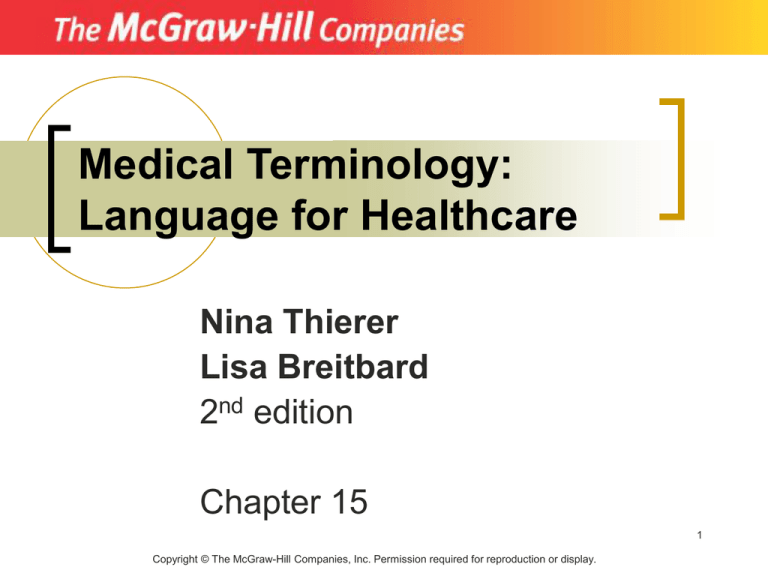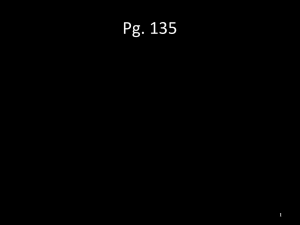
Medical Terminology:
Language for Healthcare
Nina Thierer
Lisa Breitbard
2nd edition
Chapter 15
1
Copyright © The McGraw-Hill Companies, Inc. Permission required for reproduction or display.
The Endocrine System
Pineal gland
Parathyroid
gland
Hypothalamus
Pituitary gland
Thyroid gland
Thymus
Adrenal gland
Pancreas
Ovary
2
Objectives
After studying this chapter, you will be able to:
•Name the parts of the endocrine system and
discuss the function of each part.
•Define the combining forms used in building
words that relate to the endocrine system.
•Identify the meaning of related abbreviations.
•Name the common diagnoses, clinical
procedures, and laboratory tests used in treating
disorders of the endocrine system.
3
Objectives Part 2
•List and define the major pathological conditions
of the endocrine system.
•Define surgical terms related to the endocrine
system.
•Recognize common pharmacological agents used
in treating disorders of the endocrine system.
4
Structure
and
Function
The Endocrine System
•Regulates many bodily functions
•Maintains homeostasis by regulating the
production of chemicals that affect most functions
of the body
•Secretes substances that aid the nervous system
•Important regulator of growth and development
•Endocrine glands are ductless glands, unlike
exocrine glands that secrete substances into
ducts.
5
Glands
The Endocrine System
Consists of:
glands
secrete
into
hormones
bloodstream
to
target tissues
6
Hypo/Hyper
hypo
hyper
Homeostasis exists when there is a balance of
substances. Endocrine conditions are due to either
hypo (too little) or hyper (too much) secretions of
substances (hormones).
7
Hypothalamus
Hypothalamus
•Part of the nervous system. Also serves as an
endocrine gland because it releases hormones that
regulate pituitary hormones
•Hormones released have either a releasing or an
inhibiting factor
Pineal Gland
Pituitary Gland
•Located superior and
posterior to the
pituitary gland
•Releases melatonin, a
hormone believed to
affect sleep and gonad
functioning
•Located at the base of
the brain in an area
called the sella turcica
•Is the body’s master
gland
•Consists of an anterior
and posterior lobe
8
Thyroid Gland
Thyroid Gland
•Consists of a right and left lobe, located on either
side of the trachea
•The isthmus connects the two lobes together
•Secretions control metabolism and blood calcium
concentrations
Hormones Secreted
Thyroxin (T4) and Triiodothyronine (T3)
•Functions to regulate the metabolism of
carbohydrates, lipids and proteins
Calcitonin
•Functions to help lower blood calcium levels
9
Thymus Gland
Thymus Gland
Parathyroid Gland
•Four oval shaped
glands located on the
dorsal side of the
thyroid
•Regulates calcium
and phosphate levels
•Also part of the
immune system
•The hormones
secreted stimulate the
production of T and B
cells
Adrenal Glands
•A pair of glands, each one situated on top of a
kidney
•Each gland has an outer portion (adrenal cortex)
and inner portion (adrenal medulla)
•Regulates electrolytes
•Adrenal medulla secretes catecholamines
(epinephrine and norepinephrine) in response to
stress
10
Pancreas
Pancreas
•Helps maintain proper blood
glucose levels
•Is both an endocrine and exocrine
gland. The islets of Langerhans
serve its endocrine functions
•Two types of cells, alpha and
beta are produced by the islets of
Langerhans
Elevated
Blood sugar
Insulin is released
by the beta cells
which stimulate the
glucose to be sent to
the body’s cells and
convert unused
glucose to glycogen
Blood sugar
Low
Glucagon is
released by the
alpha cells which
stimulate stored
glycogen to be
transformed into
glucose again
11
Structure and Function,
Promotes movement
Insulin and Glucagon Insulin of glucose into certain cells
Stimulates formation
Continued
of glycogen from glucose
Rise in blood glucose
stimulates insulin secretion
In response to insulin, blood
glucose drops toward normal
(and inhibits insulin secretion)
Artery
In response to glucagon,
blood glucose rises
toward normal (and
inhibits insulin secretion)
Pancreas
Drop in blood glucose
stimulates glucagon
secretion
Glucagon
Stimulates cells to break down
glycogen into glucose
Stimulates cells to convert
non-carbohydrates into glucose
12
Ovaries and Testes
Ovaries
•Located in the female
pelvic region one
attached to the top of
each fallopian tube
•Produce the female
hormones:
-estrogen
-progesterone
Testes
•Located in the scrotum,
a sac outside the body
•Produce spermatozoa
which fertilizes the
female ova
•Produce male sex
hormones:
-testosterone
13
Combining
Forms
&
Combining Form
Meaning
Abbreviations
(aden)
gland
aden(o)
adren(o)
adrenal glands
gluc(o)
glucose
glyc(o)
glycogen
gonad(o)
sex glands
pancreat(o)
pancreas
parathyroid(o)
parathyroid
thyr(o)
thyroid gland
14
Combining
Forms
&
Meaning
Abbreviation
Abbreviations
(ACTH)
ACTH
adrenocorticotropic
hormone
ADH
antidiuretic hormone
CRH
corticotropin-releasing hormone
DM
diabetes mellitus
FSH
follicle-stimulating hormone
GH
growth hormone
GTT
glucose tolerance test
HCG
human chorionic gonadotropin
15
CombiningMeaning
Forms &
Abbreviation
Abbreviations
(IDDM)
IDDM
insulin-dependent diabetes mellitus
LH
luteinizing hormone
MSH
melanocyte-stimulating hormone
NIDDM
noninsulin dependent diabetes
mellitus
PRL
prolactin
PTH
parathyroid hormone, parathormone
STH
somatotropin hormone
TSH
thyroid-stimulating hormone
16
Blood Tests
Blood Tests
•Fasting blood sugar
•Glucose tolerance test
•Thyroid function test
Other tests
•Radioactive iodine uptake
•Thyroid scan
•Radioactive immunoassay
17
Pituitary Abnormalities
Most endocrine conditions are the result of
hypersecretion or hyposecretion of one or more
hormones.
acromegaly
•Hypersecretion
of the growth
hormone which
may result in
gigantism
diabetes insipidus
•Hyposecretion of the
antidiuretic (ADH)
hormone which causes
polyuria and polydipsia
dwarfism
Pituitary
Abnormalities
•Hyposecretion of
the growth
hormone which
causes stunted
growth
syndrome of inappropriate ADH
Hypersecretion of the
antidiuretic hormone (ADH)
which causes excessive
water to be retained
18
Thyroid
Thyroid Conditions
Conditions
Hyperthyroidism
Hypothyroidism
•Also known as
Graves’ disease or
thyrotoxicosis
•Overactive thyroid
secretions may
cause exophthalmos
(bulging of the eyes)
•A goiter may also
form due to
oversecretion of
thyroid gland
•Underactive thyroid
secretion
•Signs include slow
pulse, sluggishness, and
often obesity
•Types of hypothyroidism
include:
-myxedema
-congenital
hypothyroidism
•Both can be treated with
synthetic hormones
19
Parathyroid
Conditions
Parathyroid Conditions
The parathyroid glands help control calcium levels
which contribute to bone growth and muscular health.
Hyperparathyroidism
Hypoparathyroidism
•Over activity of the
parathyroid glands
•Under activity of the
parathyroid glands causing
low blood calcium levels
•Usually caused by a tumor
•Symptoms may include the
following:
-bone loss
-kidney failure
•Common symptoms include
the following:
-bone loss
-tetany (muscle paralysis)
20
Adrenal
Conditions
Adrenal Conditions
Hyperadrenalism
Hypoadrenalism
•Overactive adrenal
gland secretion
•Under secretion of the
adrenal gland
•May be caused by a
tumor
•Also known as Addison’s
disease
•Adrenogenital
syndrome results in
symptoms of excessive
androgens affecting
both men and women
•Symptoms may include:
- anemia
- abnormal skin pigment
- general malaise
•Symptoms may include
hirsuitism, and virilism
21
Pancreatic
Pancreatic Conditions
Conditions
I’m so tired
and hungry
Pancreatitis
Inflammation of the
pancreas
Hypoglycemia
•Caused by hypersecretion of insulin
•Blood sugar levels below normal deprive the body cells
of needed glucose
•Can be controlled with dietary changes
22
Diabetes
Diabetes Mellitus
Mellitus
•Can be due to hyposecretion of insulin
•Affects about 4% of the U. S. population
Type I
•Insulin-dependent
diabetes
•Occurs in childhood
•Results from
underproduction of
insulin
•Controlled with
doses of insulin
Type II
•Noninsulin-dependent diabetes
•Usually results in overweight
people
•Several physical complications
such as:
-infection
-diabetic nephropathy
-diabetic neuropathy
-diabetic retinopathy
•Controlled with exercise and diet
23
Surgical Terms
Certain endocrine
glands that
become diseased
can be removed
Common Procedures
•adenectomy
•adrenalectomy
•hypophysectomy
•pancreatectomy
•parathyroidectomy
•thymectomy
•thyroidectomy
24
Hormone Replacement Therapy
Hormone Replacement Therapy
•Used to treat hormonal deficiencies
•Examples include synthetic
-thyroid
-estrogen
-testosterone
Antihypoglycemic
•Prevents or relieves
severe hypoglycemia
•Example
-dextrose
insulin
Antihyperglycemic
•Lowers the blood sugar
•Example
-insulin
25
Radioactive Iodine
Radioactive iodine
•Used to treat thyroid tumors
Human growth hormone
•Increases height in cases of abnormal lack of
growth
•Example
-somatotropin
Steroid
•Increases
growth
•Example
-prednisone
26
1.
Apply Your Knowledge
Identify the following
labeled endocrine
organs
1. pineal gland
2. parathyroid gland
2.
3.
Hypothalamus
Pituitary
gland
4.
5.
6.
7.
8.
3. hypothalamus
4. pituitary gland
5. thymus
6. adrenal gland
7. pancreas
8. ovary
27
Apply Your Knowledge Part 2
Which of the following endocrine glands is located
in the sella turcica?
A. Pineal
B. Pituitary
C. Adrenal
Answer: B. Pituitary
28
Apply Your Knowledge Part 3
A lack of which of the following nutrients in the
bloodstream will adversely affect the body’s
metabolism?
A. carbohydrates
B. sodium
C. iodine
Answer: C. iodine
29
Apply Your Knowledge Part 4
Carrie, age 5 has been diagnosed with diabetes
mellitus. Which type of diabetes would she more
than likely have?
A. insulin-dependent
B. noninsulin-dependent
C. Type II
Answer: A. insulin-dependent
30











